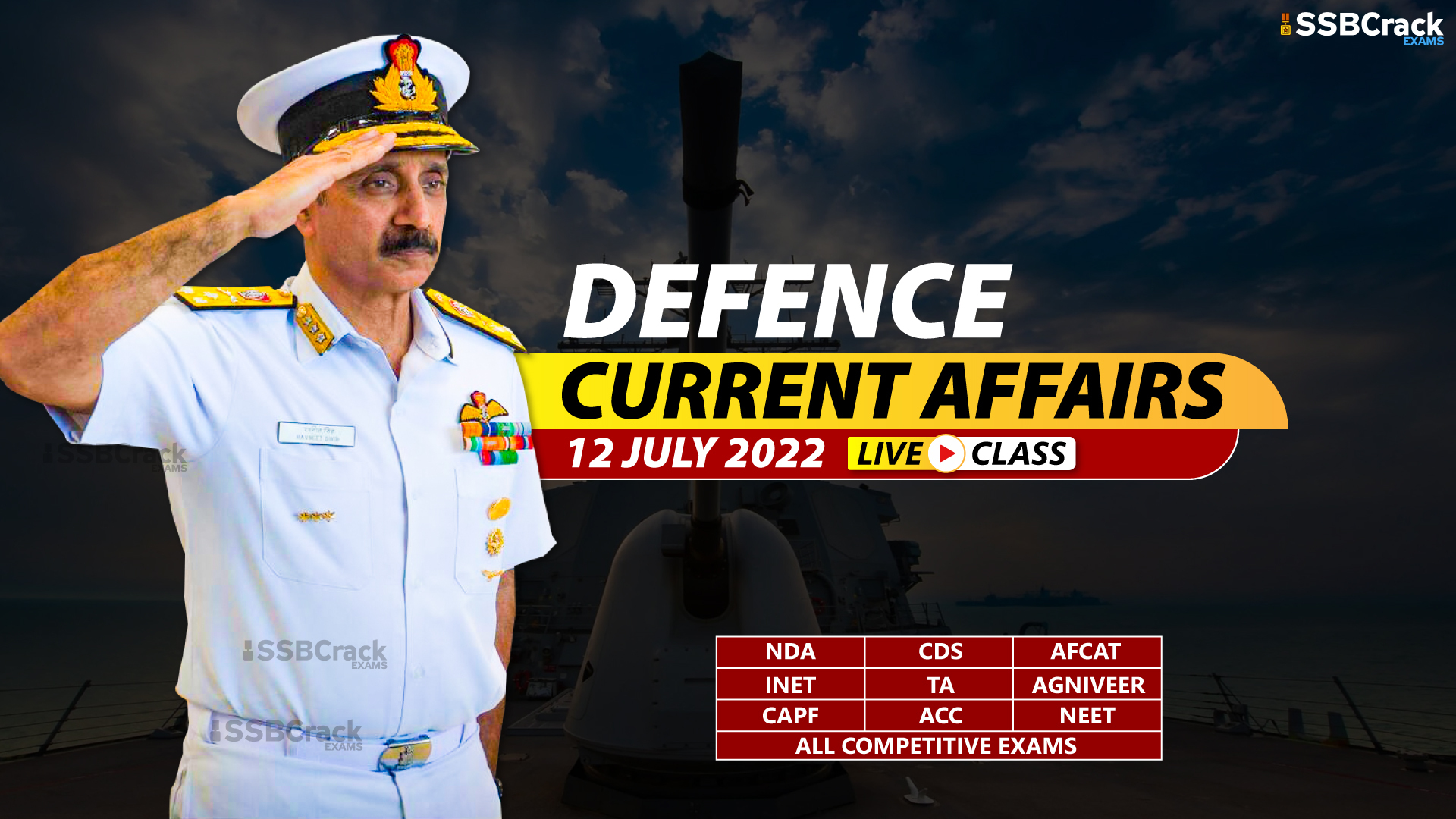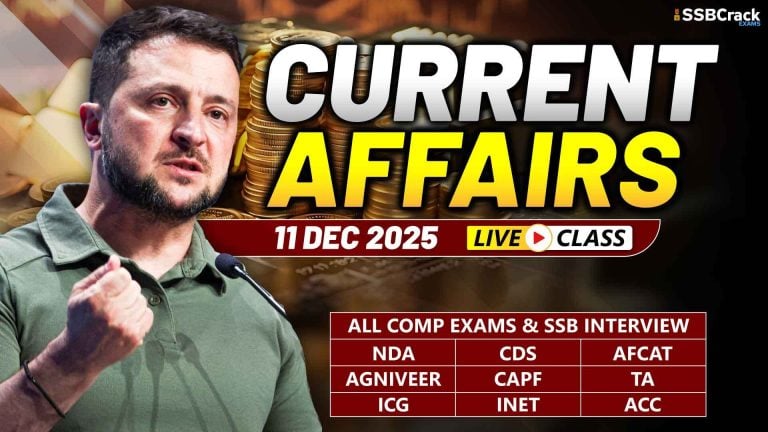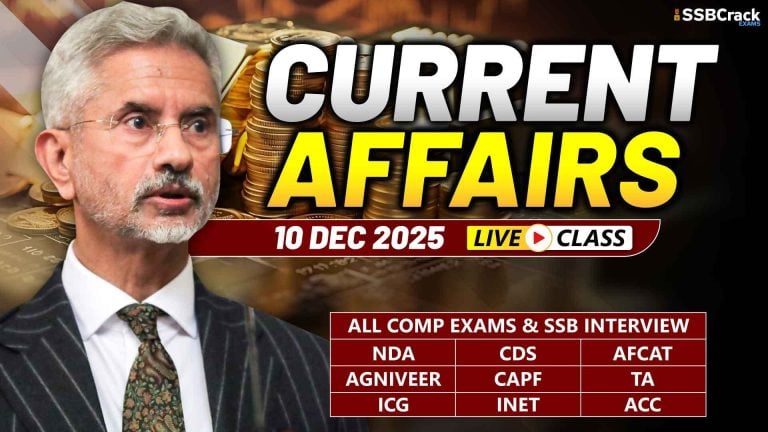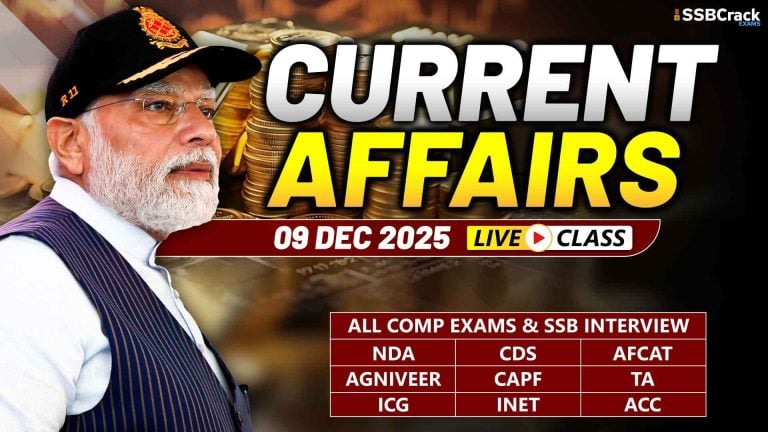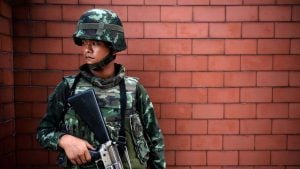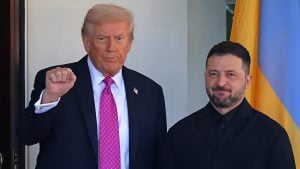In today’s 12 July 2022 Defence Current affairs and updates, we are going to see the latest defense-related updates on national and international current affairs topics. These current affairs questions and major events will be really helpful for your upcoming NDA, CDS, AFCAT, TA, INET, MNS, ACC exams, and other SSB interviews and AFCAT interviews like SSC Tech, TGC, TES, NDA, CDS, AFCAT, and more. Download the current affairs PDF file at the end of this article.
Daily Defence Current Affairs 12 July 2022
China And Pakistan Kick Off Naval, Air Drills
- All-weather friends China and Pakistan on Sunday kicked off their ‘Sea Guardians-2’ drills off the Shanghai coast by deploying their new high-tech naval ships and fighter jets to “jointly deal with maritime security threats,” as their navies stepped up cooperation in India’s backyard, the Indian Ocean.
- The Chinese People’s Liberation Army (PLA) Navy and the Pakistan Navy, will hold the joint naval exercise in maritime and aerial spaces off Shanghai in mid-July, Captain Liu Wensheng, a spokesperson for the PLA Navy.
- Themed “jointly dealing with maritime security threats,” the exercise will feature training courses including the joint strike against maritime targets, joint tactical manoeuvring, joint anti-submarine warfare and joint support for damaged vessels.
- Besides building its first military base in Djibouti in the Horn of Africa in the Indian Ocean, China has acquired Pakistan’s Gwadar port in the Arabian Sea which connects with China’s Xinjiang province by land in the USD 60 billion China Pakistan Economic Corridor (CPEC).
General Manoj Pande COAS Released The Book “Cavaliers Take – Memoir Of A Soldier’s General
- General Manoj Pande COAS released the book “Cavaliers Take – Memoir of a Soldier’s General” by Lt Gen Rajan Bakhshi (Retd). The book is a compilation of Lt Gen Bakhshi’s real-life experiences, ranging from challenges of the service life to humour in uniform.
- As part of the Indian army for over 40 years, the book is a compilation of Gen Bakhshi’s real-life experiences, ranging from humour in uniform to challenges overcome during his command of the Ladakh corps. The book offers real-life personality-based narratives of lesser-known army men, who are worthy of high acclaim.
- Actual incidents and the role of destiny in the most hazardous and challenging environs of Ladakh, including the highest battle field in the world – the Siachen Glacier. Humour in uniform in the peacetime soldiering mode with real-life episodes ranging from young officer days to senior ranks. A glimpse of life in the fieldformations and a commentary on the national mobilization after the terrorist attack on the Parliament making it a mixed bag of short stories.
- During his tenure as the Central Army commander, Gen Bakhshihad initiated orientation sessions about the Indian Army for the larger civilian population. With encouraging feedback from the audience via packed auditoriums the General soon realised that the youth of the nation was keen to know more about their army and these sessions gained momentum and reached out to schools and various other institutions subsequently.
- Speaking at the book launch, said General Manoj Pande said, “A fourth-generation army officer and the only tank-man to have commanded the prestigious Ladakh corps Lt Gen Rajan Bakhshi’s ‘Cavalier’s Take – Memoir of a Soldiers General’ is neither a travelogue nor a figment of imagination. Each story is a real life happening with live characters and actual existing locations in the country.”
Army Quietly Raised Its First LCH Squadron
- The Army Aviation Corps is in the process of a major augmentation of its firepower with the induction of the indigenous LCH underway, and Apache attack helicopters from 2024 onwards. However, its fleet of ageing Cheetah and Chetak helicopters, which are a lifeline for high-altitude areas, are in dire need of replacement.
- Of the 190 Cheetahs and Chetaks in service, around 134 helicopters or over 70% of them are over 30 years old. The LUH, designed and developed by HAL.
- LCH squadron- On June 1, 2022, the Army raised its first LCH squadron at Bengaluru. “It will move to Eastern Command on completion next year,” the official stated adding that, in all, seven LCH units are planned, each having 10 helicopters for combat roles in the mountains.
- The Army has three Aviation Brigades at Leh, Missamari and Jodhpur. It operates around 145 indigenous ALH, 75 of which are the Rudra weaponised variants. Another 25 ALH Mk-III are on order and will be inducted within two years
India Has Committed $3.8 Billion Dollars To Sri Lanka: S Jaishankar
- External Affairs Minister S Jaishankar on Sunday said India has committed USD 3.8 billion for the support of Sri Lanka during the latter’s economic crisis which had been building up over a period of time.
- The union minister said Prime Minister Narendra Modi has a neighbourhood first policy where the government makes special efforts to try and support the country’s neighbours in a manner that meets their requirements.
- “In the case of Sri Lanka, we have given them a line of credit which has kept essential commodities flowing to them from India over the last several months. We also gave them a line of credit for purchase of fuel. At the moment, our focus is on helping them recover.
- “This year alone, we have committed around 3.8 billion (US) dollars to them in terms of supporting them. We have been their biggest supporter. It is one of the reasons why they have been able to prevent the situation from becoming worse,” the minister said in response to queries by reporters at a press conference here.
- The Union minister also said there was no refugee crisis as of now. “I do not think we can call it a crisis. Occasionally, some people have come from there, but right now I do not think there is any justification for calling it a refugee crisis,.
- The relationship between India and Sri Lanka is more than 2,500 years old.
- Both countries have a legacy of intellectual, cultural, religious and linguistic interaction.
- In recent years, the relationship has been marked by close contacts at all levels. Trade and investment have grown and there is cooperation in the fields of infrastructure development, education, culture and defence.
- In recent years, significant progress in implementation of developmental assistance projects has further cemented the bonds of friendship between the two countries.
- The nearly three-decade long armed conflict between the Sri Lankan forces and the LTTE came to an end in May 2009. During the course of the conflict, India supported the right of the Sri Lankan Government to act against terrorist forces.
- India’s consistent position has been in favour of a negotiated political settlement, which is acceptable to all communities within the framework of a united Sri Lanka and is consistent with democracy, pluralism and respect for human rights.
Background
- The relationship between India and Sri Lanka is more than 2,500 years old.
- Both countries have a legacy of intellectual, cultural, religious and linguistic interaction.
- In recent years, the relationship has been marked by close contacts at all levels. Trade and investment have grown and there is cooperation in the fields of infrastructure development, education, culture and defence.
- In recent years, significant progress in implementation of developmental assistance projects has further cemented the bonds of friendship between the two countries.
- The nearly three-decade long armed conflict between the Sri Lankan forces and the LTTE came to an end in May 2009. During the course of the conflict, India supported the right of the Sri Lankan Government to act against terrorist forces.
- India’s consistent position has been in favour of a negotiated political settlement, which is acceptable to all communities within the framework of a united Sri Lanka and is consistent with democracy, pluralism and respect for human rights.
Geopolitical Significance of Sri Lanka
- Sri Lanka’s location in the Indian Ocean region as an island State has been of strategic geopolitical relevance to several major powers.
- Some examples that highlight Western interests in Sri Lanka’s strategic location are the British Defence and External Affairs Agreement of 1948, and the Maritime Agreement with USSR of 1962.
- Even during the J.R Jayewardene (1978-1989) and Ranasinghe Premadasa (1989-1993) tenures, Sri Lanka was chosen to build the Voice of America transmitting station (suspected of being used for intelligence gathering purposes and electronic surveillance of the Indian Ocean).
- It was the massive Chinese involvement during the Rajapaksa tenure that garnered the deepest controversy in recent years.
- China is building state of the art gigantic modern ports all along the Indian Ocean to the south of it, in Gwadar (Pakistan), Chittagong (Bangladesh, Kyauk Phru (Myanmar) and Hambantota (Sri Lanka).
- China’s string of pearl’s strategy is aimed at encircling India to establish dominance in the Indian Ocean.
- Post 2015, Sri Lanka still relies heavily on China for Port city project and for continuation of Chinese funded infrastructure projects in Sri Lanka.
- Although the Hambantota harbour is reportedly making losses, it too has potential for development due to its strategic location.
- Sri Lanka has a list of highly strategic ports located among busiest sea lanes of communication.
- Sri Lanka’s Colombo Port is the 25th busiest container port in the world and the natural deep-water harbor at Trincomalee is the fifth largest natural harbour in the world.
- Port city of Trincomalee was the main base for Eastern Fleet and British Royal Navy during the Second World War.
- Sri Lanka’s location can thus serve both commercial and industrial purposes and be used as a military base.
Political Relations
- As a country that emerged from a civil war facing human rights allegations; the domestic politics and international relations of Sri Lanka are heavily geopolitical with foreign powers having vested interests.
- Political relations between India and Sri Lanka have been marked by high-level exchanges of visits at regular intervals.
- In February 2015, Sri Lanka’s newly elected President Maithripala Sirisena undertook his first official visit to India, and Modi paid a return visit to Colombo in March 2015. He was the first Indian prime minister to do a stand-alone visit to Sri Lanka in 28 years.
- In June 2019, the first overseas visit of Indian Prime Minister to Sri Lanka, in his second term, is an important symbolic gesture reflective of the special relationship between the countries.
- Sri Lanka is a member of regional groupings like BIMSTEC (Bay of Bengal Initiative for Multi-Sectoral Technical and Economic Cooperation) and SAARC in which India plays a leading role.
- Recently, India has invited leaders of BIMSTEC member countries to attend the swearing-in of Prime Minister Narendra Modi and his council of ministers. This is in line with the government’s focus on its ‘Neighbourhood First’ policy.
- Sri Lanka has long been in India’s geopolitical orbit, but its relationship with China has strengthened in recent years.
- Former President Rajapaksa took Sri Lanka closer to China and sidelining Indian concerns including over the rehabilitation of Tamils displaced by the long-running Sri Lankan civil war.
- The Palk Strait, about 40 km (25 miles) wide at its narrowest point, separates the southern Indian state of Tamil Nadu and northern Sri Lanka, traditionally the main Tamil area of the Indian Ocean Island.
- When war between Sri Lankan Tamils and the Sinhalese majority erupted in 1983, India took an active role.
- Indo-Sri Lankan Accord was signed in 1987 to provide a political solution to Sri Lanka’s conflict.
- It proposed the establishment of provincial council system and devolution of power for nine provinces in Sri Lanka (also known as The Thirteenth Amendment).
- India deployed Indian Peace Keeping Force (IPKF) in Sri Lanka under Operation Pawan to disarm the different militant group.
- IPKF was later withdrawn after three years amidst escalating violence.
- The violent conflict was ended in 2009 and at that point of India has agreed to reconstruct the war-torn areas and started many rehabilitation programs.
- India voted against Sri Lanka in 2009, 2012 and 2013 at the US-sponsored UNHRC resolution to investigate alleged human rights violations in Sri Lanka.
Commercial Relations
- Sri Lanka has long been a priority destination for direct investment from India.
- Sri Lanka is one of India’s largest trading partners among the SAARC countries. India in turn is Sri Lanka’s largest trade partner globally.
- India’s exports to Sri Lanka amounted to $5.3 billion in 2015-17 whereas its imports from the country were at $743 million.
- Trade between the two countries grew particularly rapidly after the India-Sri Lanka Free Trade Agreement which came into force in March 2000.
- While Sri Lankan exports to India have increased substantially during the past several years since 2000 when ISFTA came into force.
- However, there has been a high growth in India’s exports to Sri Lanka, resulting in a widening of the balance of trade. This is largely because of the lack of export capacity from Sri Lanka to service Indian requirement and also due to increase in imports from India because of competitiveness of our exports.
Cultural and Educational Relations
- The Cultural Cooperation Agreement signed by the two Governments on 29 November, 1977, forms the basis for periodic Cultural Exchange Programmes between the two countries.
- The Indian Cultural Centre in Colombo actively promotes awareness of Indian culture by offering classes in Indian music, dance, Hindi and Yoga. Every year, cultural troupes from both countries exchange visits.
- India and Sri Lanka commemorated the 2600th year of the attainment of enlightenment by Lord Buddha (Sambuddhathva Jayanthi) through joint activities.
- The two Governments also celebrated the 150th Anniversary of Anagarika Dharmapala in 2014.
- The India-Sri Lanka Foundation, set up in December 1998 as an intergovernmental initiative, also aims towards enhancement of scientific, technical, educational and cultural cooperation through civil society exchanges and enhancing contact between the younger generations of the two countries.
- Education is an important area of cooperation. India now offers about 290 scholarship slots annually to Sri Lankan students.
- In addition, under the Indian Technical and Economic Cooperation Scheme and the Colombo Plan, India offers 370 slots annually to Sri Lankan nationals.
- Government of India formally launched the e-Tourist Visa (eTV) scheme for Sri Lankan tourists on 14 April 2015 to increase the people to people contact.
- Subsequently, in a goodwill gesture, the visa fee for eTV was sharply reduced.
Defence and Security Cooperation
- Sri Lanka and New Delhi have long history of security cooperation. In recent years, the two sides have steadily increased their military-to-military relationship.
- India and Sri Lanka conducts joint Military (‘Mitra Shakti’) and Naval exercise (SLINEX).
- India also provides defence training to Sri Lankan forces.
- A trilateral maritime security cooperation agreement was signed by India, Sri Lanka and the Maldives to improve surveillance, anti-piracy operations and reducing maritime pollution in Indian Ocean Region.
- In April 2019, India and Sri Lanka also concluded agreement on countering Drug and Human trafficking.
- In the aftermath of the horrific Easter bombings, Sri Lankan Prime Minister thanked the Indian government for all the “help” given.
- The alerts issued by Indian agencies before the attacks had warned specifically about the use of radicalised suicide bombers attacking churches and the Indian High Commission in Colombo.
Türkiye’s Tests Gokdogan 60km Air-to-air Missile, Pakistan Likely To Be First Customer
- Türkiye has successfully test-fired its domestically developed beyond visual range air-to-air missile (BVRAAM), Gokdogan, the head of the Presidency of Defense Industries (SSB), Ismail Demir, said.
- Both missiles are equipped with high thrust-low smoke solid-fuel technology, a full electronic rocket engine, safe start and ignition systems with high reliability and safety levels, and a continuous fuse for high safety and reliability.
- SAGE’s work on air-to-air missiles began in 2013. It developed Gokdogan as a short-range, high maneuverability, infra-red seeker, and Bozdogan as a long-range, active radar seeker missile.
REVIEW QUESTIONS
- Gokdogan Is A
- Air to Air Missile
- Destroyer
- Helicopter
- Surface to Surface
ANSWER: A
- The G20 was formed in
- 1997
- 1998
- 1999
- 2000
ANSWER: C
- India Will Assume The Presidency Of The G20 In
- December 2021
- December 2022
- December 2023
- December 2024
ANSWER: B
- Which Isn’t India’s Priorities in G20 Summits
- Checking tax evasion to fight corruption
- Choking terror funds
- Market access for key drugs
- Compete with China
ANSWER: D
- Current President of Sri Lanka Is
- Gotabaya Rajapaksa
- Ranil Wickremesinghe
- Tilak Ratane Dilshan
- None
ANSWER: A
- Ordnance Factories Day Is Observed On
- March 13
- March 14
- March 17
- March 18
ANSWER: D
- Lieutenant Rank Of Indian Army Is Equivalent To Which Rank Of Indian Navy?
- Admiral
- Commodore
- Captain
- Sub Lieutenant
ANSWER: D
- The President Of India Has The Power Of Pardoning Under _____.
- Article 72
- Article 73
- Article 74
- Article 76
ANSWER: A
- “Failure Comes Only When We Forget Our Ideals And Objectives And Principles”. Said By__
- Jawaharlal Nehru
- Gandhi Ji
- Subhas Chandra Bose
- Bhagat Singh
ANSWER: A
- SLINEX 2022 Held At
- Columbo
- Kochi
- Dhaka
- Vishakhapatnam
ANSWER: D
- Mitra Shakti Ex Conducts B/W
- India & Indonesia
- India & UK
- India & Sri Lanka
- India & Thailand
ANSWER: C
- The National Disaster Management Authority (NDMA) Is In
- Pune
- Noida
- New Delhi
- Mumbai
ANSWER: C
- The National Disaster Management Authority (NDMA) Is Headed By
- Governor
- Chief Justice Of India
- Union Home Minister
- The Prime Minister
ANSWER: D
- Riga Is The Capital Of
- Latvia
- Lesotho
- Libya
- Maldives
ANSWER: A
- “Paradise Lost” Book Is Written By
- John Milton
- Rabindranath Tagore
- Pearl S. Buck
- Vishnu Sharma
ANSWER: A
- Next Indian Sherpa In G 20 Summit Will be?
- Amitabh Kant
- Piyush Goyal
- Rajiv Kumar
- Narendra Modi
ANSWER: A
- Pakyong Airport is located in –
- Sikkim
- Assam
- Arunachal Pradesh
- Nagaland
ANSWER: A
- Which port is also known as the New Mangalore Port?
- Mormugao Port
- Panambur Port
- Kandla Port
- Tuticorin Port
ANSWER: B
- Joint Comprehensive Plan Of Action (JCPOA) Is Related To
- Agriculture
- Military Ceasefire
- Space Technology
- Nuclear Capability
ANSWER: D
- 20. Sagarmala Programme was launched in
- 2014
- 2015
- 2016
- 2017
ANSWER: B
ALSO READ:
- Latest Daily Current Affairs and Defence Updates
- June 2022 Monthly Defence Current Affairs And Updates [DOWNLOAD PDF]
- May 2022 Monthly Defence Current Affairs And Updates [DOWNLOAD PDF]
- April 2022 Monthly Defence Current Affairs And Updates [DOWNLOAD PDF]
- March 2022 Monthly Defence Current Affairs And Updates [DOWNLOAD PDF]
- February 2022 Monthly Defence Current Affairs And Updates [DOWNLOAD PDF]
- January 2022 Monthly Defence Current Affairs And Updates [DOWNLOAD PDF]
